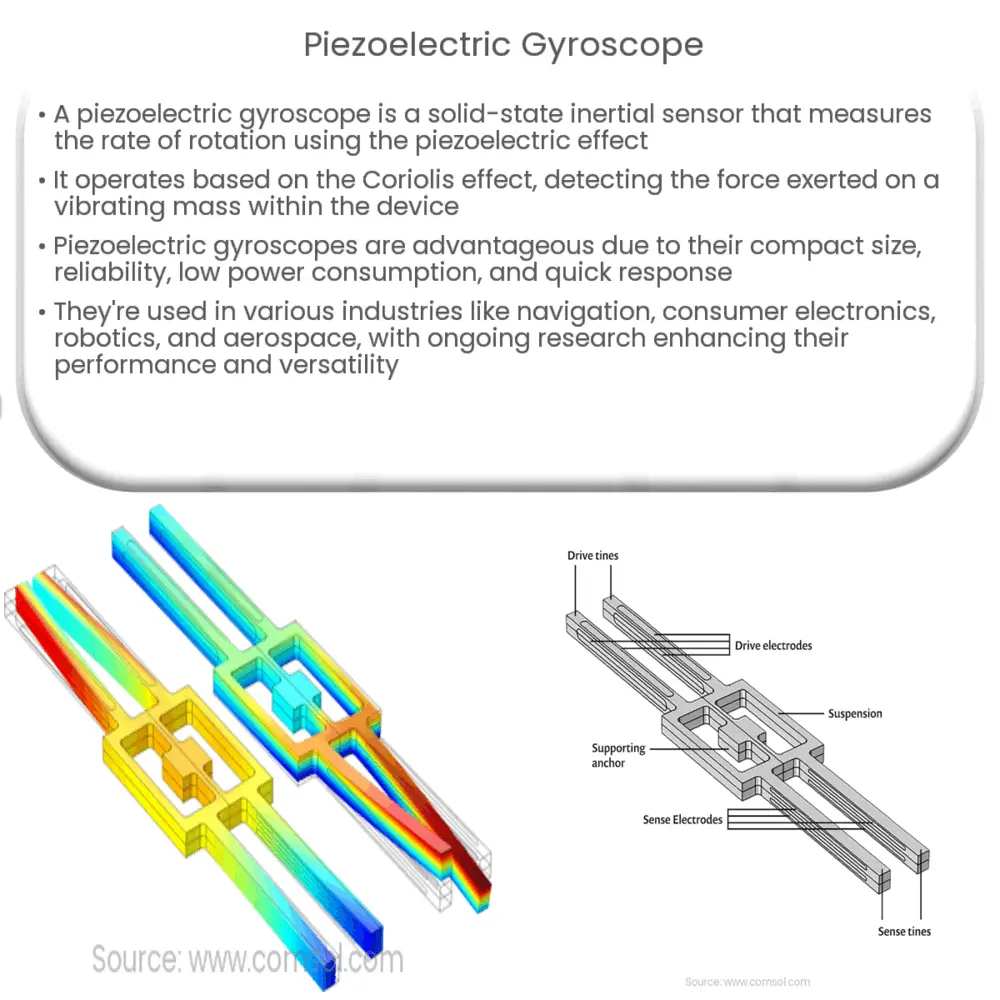A piezoelectric gyroscope is a compact, lightweight sensor that measures angular velocity using the piezoelectric effect and Coriolis force.

Piezoelectric Gyroscope: A Comprehensive Introduction
What is a Piezoelectric Gyroscope?
A piezoelectric gyroscope is a type of solid-state inertial sensor that measures the rate of rotation, also known as angular velocity, of an object in three-dimensional space. This technology is based on the piezoelectric effect, which is the generation of an electric charge in response to mechanical stress applied on certain materials. Piezoelectric gyroscopes have a wide range of applications, including robotics, aerospace, and navigation systems.
Working Principle of Piezoelectric Gyroscope
The fundamental principle behind the piezoelectric gyroscope is the Coriolis effect, a phenomenon observed in rotating systems. When a mass moves in a rotating frame, it experiences a force called the Coriolis force, which acts perpendicular to the direction of motion and the axis of rotation. The piezoelectric gyroscope utilizes this effect to measure angular velocity by detecting the Coriolis force exerted on a vibrating mass.
The piezoelectric gyroscope consists of a vibrating structure, typically a tuning fork, beam, or ring, made from a piezoelectric material. When an alternating voltage is applied to the structure, it vibrates at its resonant frequency, generating mechanical stress within the material. If the gyroscope is subjected to an angular rotation, the Coriolis force acts on the vibrating structure, causing it to twist or deform. This deformation results in a change in the stress distribution within the piezoelectric material, which in turn generates an electrical signal proportional to the angular velocity. By measuring this electrical signal, the rate of rotation can be determined.
Advantages of Piezoelectric Gyroscope
Piezoelectric gyroscopes offer several advantages compared to other types of gyroscopes, such as mechanical and fiber-optic gyroscopes. Some of the main benefits include:
- Compact Size and Lightweight: Due to the solid-state nature of the piezoelectric gyroscope, it has a smaller form factor and lower weight than its counterparts. This makes it suitable for applications where space and weight are critical factors.
- High Reliability: The absence of moving parts in piezoelectric gyroscopes reduces wear and tear, resulting in improved reliability and a longer operational life.
- Low Power Consumption: Piezoelectric gyroscopes typically consume less power than other types of gyroscopes, making them an attractive option for battery-powered devices and energy-sensitive applications.
- Fast Response Time: The high resonant frequency of piezoelectric materials allows for rapid detection of angular velocity changes, providing quick and accurate measurements.
Despite these advantages, piezoelectric gyroscopes also have some limitations, including sensitivity to temperature changes and susceptibility to shock and vibration. However, ongoing research and development efforts aim to address these challenges and improve the performance of piezoelectric gyroscopes.
Applications of Piezoelectric Gyroscope
Piezoelectric gyroscopes have a wide range of applications across various industries due to their unique characteristics. Some notable applications include:
- Navigation Systems: Piezoelectric gyroscopes are used in navigation systems for vehicles, ships, and aircraft to provide accurate orientation and position information. They are also used in inertial navigation systems (INS) to maintain a stable platform for guidance and control.
- Consumer Electronics: In smartphones, tablets, and gaming devices, piezoelectric gyroscopes contribute to motion sensing and control. They enable features like screen rotation, gesture recognition, and enhanced gaming experiences.
- Robotics: Piezoelectric gyroscopes are essential components in robotic systems, providing stability and precise movement control. They are particularly useful in autonomous robots, where accurate orientation data is crucial for navigation and obstacle avoidance.
- Aerospace: In satellite and space vehicle systems, piezoelectric gyroscopes help maintain attitude control and stabilize onboard equipment, ensuring the proper functioning of communication and imaging systems.
Recent Developments in Piezoelectric Gyroscope Technology
Technological advancements in materials science, fabrication techniques, and signal processing have led to significant improvements in the performance of piezoelectric gyroscopes. Some recent developments include:
- New Piezoelectric Materials: Researchers are exploring novel piezoelectric materials with improved properties, such as higher electromechanical coupling, better temperature stability, and increased sensitivity. These materials could lead to more accurate and reliable piezoelectric gyroscopes.
- Advanced Fabrication Techniques: Micro-electromechanical systems (MEMS) technology has enabled the miniaturization of piezoelectric gyroscopes, resulting in devices with a smaller footprint and reduced power consumption. MEMS-based piezoelectric gyroscopes are increasingly being integrated into consumer electronics and other compact applications.
- Enhanced Signal Processing: Improved algorithms and digital signal processing techniques have been developed to address the inherent noise and drift issues associated with piezoelectric gyroscopes, leading to more accurate and stable measurements.
Conclusion
Piezoelectric gyroscopes have come a long way since their inception, offering numerous advantages over traditional mechanical and fiber-optic gyroscopes. Their compact size, lightweight nature, high reliability, low power consumption, and fast response time make them suitable for a wide range of applications. While there are still challenges to overcome, ongoing research and development efforts continue to push the boundaries of piezoelectric gyroscope technology, paving the way for even more advanced and versatile devices in the future.

